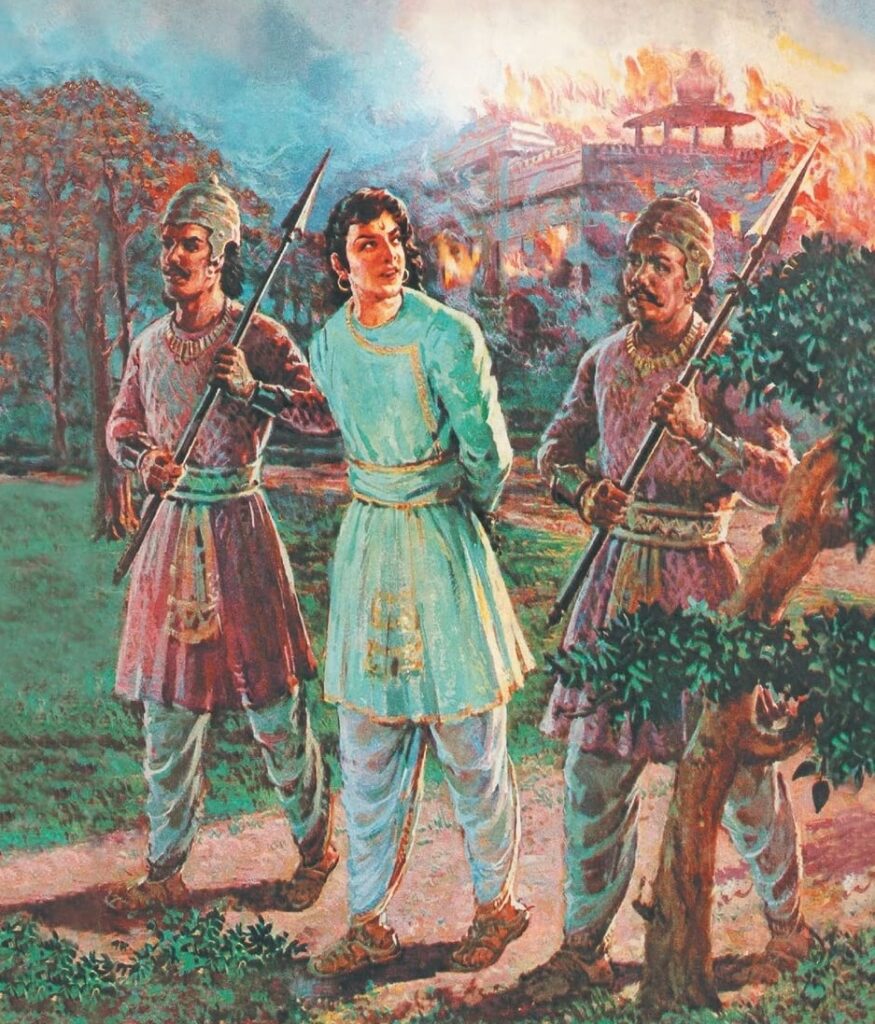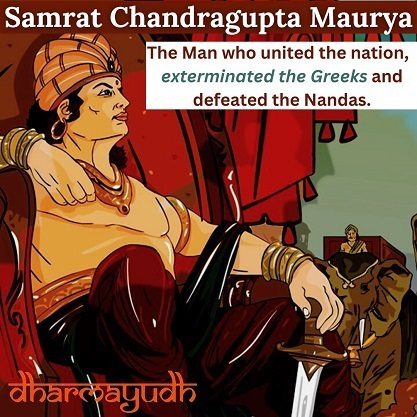Chandragupta Maurya is a fascinating figure in the pages of Indian history. The king who carved out one of the greatest and biggest empires of India. He uprooted the great Nanda Empire under the able guidance of Chanakya and established the Mauryan hegemony over the sub-continent.

Under him, the empire progressed rapidly both politically and culturally. In the words of the Greek historian, Megasthenes, Chandragupta was a hard-working king who always prioritized public work over his sleep.
The Greeks, Buddhists, and Jain texts described Chandragupta’s long career in their texts which gives us glimpses of his greatness.
Content
Background: Early Life
Although there are several sources that provide information about Chandragupta Maurya and his career although the information about his early life still needs historians’ confirmation.
Different sources tell different stories about the early life and the origin of Chandragupta Maurya.

The Buddhist texts like Divyavadana and Mahavamsa mentioned that the Mauryan emperor was a Kshatriya. But sources like that of Justin (Greek writer) mentioned Chandragupta as of a lower caste.
Mudra-Rakshasa a historical play that was originally written in Sanskrit by Vishakadutta also mentions the Mauryan emperor as Vrishala (of low origin).
Furthermore, according to other sources Chandragupta’s father belonged to the Moriya clan. But to the demise of his father his mother took the young Chandragupta to Pataliputra.
Another story that further sheds the light on the origin of the first Mauryan emperor is that he belonged to the family of the Nandas.
However, it is difficult to conclude anything about the origin of this great emperor of the Mauryas.
Meeting with Chanakya: Rise of Samrat Chandragupta
According to the legends, the first meeting between Chanakya and Chandragupta took place when the latter was playing the role of a king among his friends.
Note: Chanakya was a teacher of political science and economics at the famous Taxila University.
Chanakya saw the leadership acumen in the young spirit of Chandragupta and decided to make the young child the master of the subcontinent.
Chanakya took Chandragupta to Taxila and educated the latter in every possible field including science and polity.
Dhanananda (r329-321 BC) was the last king of the famous Nanda dynasty. He is described as an arrogant ruler. During his reign, the region of the Magadha or Nanda Empire possessed an enormous amount of wealth.
Some historians have described the personality of Dhana Nanda as a cruel and arrogant king who took heavy taxes from the peasants.
According to the legends the Nanda Emperor insulted Chanakya in his court and due to this, the latter took an oath of uprooting the tyranny of the Nanda Emperor. Furthermore, Chanakya was also aware of the presence of the Greeks.
He realized that the nation was in grave danger due to the rise of the Macedonian army and Alexander. The pillage and plundering done by the foreign invasion alarmed the great Chanakya and he wasted no time in order to secure the national frontiers of Bharat.
He then met the young and spirited Chandragupta and decided to initiate his master plan with the latter support. After eight years of teaching and training, Chandragupta took the task of uniting the subcontinent under the Mauryan flag.
Initially, he recruited his troops from the northwestern region of the country. Later his army became a combination of several communities like Yavanas, Sakas, Kambojas, Kiratas, etc.
The Jain and Buddhist sources mentioned that Chandragupta had formed an alliance with Parvartaka who is believed to be the king of the Himalayan region.
Towards First Victory: Defeat of the foreign settlements
After the retreat of the Macedonians, their conquered territories faced the tides of rebellion from the native population.
Chandragupta took this opportunity and used it for his grand plan. According to the Greek writer Justin, in the period between 325-323 CE or probably after the death of Alexander in 323 BC Sandrocottos defeated the Greek governors one after the other.
These campaigns might have lasted till 317 BC. Furthermore, it is also believed that these campaigns of Chandragupta might have started in the region of Sindhu valley as early as 323 BC.

The young king established his hegemony over Punjab and Sindh after exterminating the foreign yoke. Justin mentioned that the Macedonian settlements were suppressed by the Mauryan king.
Struggle against the Nandas
After securing the northwest frontier from the Greeks Chandragupta marched towards Nanda Empire. The eastern campaigns of Chandragupta are not properly documented.
According to Mahavamsa a Buddhist text the initial campaigns of Chandragupta resulted in failure. Similarly, the Buddhist text also suggests that initially, the Mauryan king didn’t get enough success as he was attacking the central part of the enemy’s territory.
Furthermore, the Puranas also mentioned that the Nanda Empire was overthrown by Kautilya and Chandragupta.
Later the Mauryan king realized his mistake and took inspiration from a story according to which a child mistakenly burnt his hand while eating Khichdi (a type of pie) from the center where it was super hot. Later his mother scolded him and suggested that he should have started eating the pie from the edge rather than from the center.
Chandragupt took inspiration from this story and after realizing his mistake and under the proper guidance of Chanakya he conquered the empire of the Nandas and defeated their last king Dhanananda.
It is not clear what happened to Dhanananda. Some historians suggest that he was killed in the battle while others argue that he fled.
Clash against Seleucus
In 305 CE Chandragupta crossed swords with the Greek king Seleucus Nikator. The Greek king was the commander of the Greeks during the period of Alexander.
Seleucus was ruling the region of the eastern portion of Alexander’s empire. It is believed that the Greek monarch faced defeat in this struggle and he was forced to give up the territories of Herat, Kabul, Baluchistan, and Qandahar in return for 500 elephants.
The details of this epic struggle are available but it is confirmed that the Indian king had the upper hand in this conflict. Furthermore, Seleucus also sent an ambassador known as Megasthenes who wrote the famous book called Indica.
The extent of the Empire and the last days
Chandragupta Maurya united almost the whole of India and according to Plutarch (Greek scholar and philosopher), the Mauryan emperor was ruling the entire subcontinent.

The region of Bihar, Bengal, North West India, Deccan, and south (excluding the extreme south regions)all fell under the banner of Chandragupta. Also, the empire of the third Mauryan king i.e. Ashoka was literally the empire of Samrat Chandragupta as the inscription of the former had mentioned the conquest of Kalinga only.
So we can say that most of the territories which King Ashoka ruled were originally part of Chandragupta’s empire too.
According to the Jain texts, the Mauryan king abdicated the throne and adopted Jainism. Bhadrabahu a Jain monk became the spiritual teacher of Chandragupta and both went to Shravana Belagola (Mysore).
In his last days, the Mauryan Emperor performed Sallekhana (fasting to death).
Chandragupta Maurya is an inspirational figure who united the whole subcontinent under the able guidance of Chanakya. The king defeated the Greeks and took the region of Kabul and Herat which even the British failed to conquer.
Through his dauntless courage and spirit, the Indian subcontinent witnessed its first golden age.
Donate to our Cause
If you support what we are doing and would like to contribute to help us grow and reach more Indians to teach them more about such forgotten historic Indian Heroes and stories, please consider donating any amount. It will help us grow

